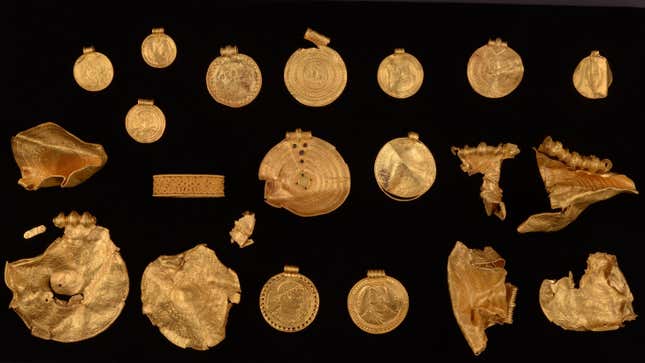
Archaeologists in Denmark are stunned after the discovery of a huge Iron Age gold hoard near Jelling. Dating back some 1,500 years, the relics include saucer-sized medallions and coins from the Roman Empire.
For metal detectorists, it doesn’t get much better than this. Ole Ginnerup Schytz had only recently acquired his metal-sniffing device when he got permission to probe a schoolmate’s property in Vindelev, a Danish town located 10 minutes from Jelling. Schytz had only been working for a few hours when he stumbled upon the dream find: a gigantic gold hoard dating back to the Danish Iron Age.
Archaeologists with Vejlemuseerne and the National Museum were called in to conduct a full excavation. In total, nearly 2.2 pounds (1 kg) of gold was pulled from the ground. That’s about $56,000 worth of gold by today’s standards. A Vejlemuseerne press release says it’s one of the “largest, richest and most beautiful gold treasures” ever found in Denmark.

The Vindelev Hoard, as it’s now called, was found at the site of a former longhouse. A village stood here some 1,500 years ago, approximately 300 years before the onset of the Viking Age.
The relics included bracteates, round gold pendants typically worn as part of a necklace. Some were the size of coffee saucers and decorated with motifs and runic inscriptions. Preliminary analysis suggests the runes make reference to Norse mythology or contemporary rulers, but more study is needed. One bracteate features a braided male head in apparent conversation with a horse and bird. A runic inscription on the relic makes reference to “the high one,” a possible reference to Odin or the chieftain who buried the hoard, according to the press release.

The stash also included Roman coins crafted into jewelry. One particularly heavy gold coin dates back to Constantine the Great (272-337 CE), the emperor who, in 313 CE, declared tolerance for Christianity in the Roman Empire. By the time it got to Vindelev, this gold coin was already quite old, pointing to the interconnectedness of Europe during the Iron Age—an interconnectedness made possible by conquest and trade.
The fantastic relics are destined for a museum, but the find is of archaeological importance. For one, the substantial gold hoard shows that Vindelev was a village of prominence during this time period.

“Only a member of the absolute cream of society would have been able to collect a treasure like the one found here,” explained Mads Ravn, head of research at Vejlemuseerne, in the museum release. “Although the name Vindelev can be linked to the time of migration, there was nothing that indicated that a previously unknown warlord or chieftain lived here, long before the kingdom of Denmark arose in the following centuries.”
Indeed, the hoard would suggest the presence of a powerful chieftain who ruled in the early 6th century during the Late Iron Age. The chieftain presumably acquired this wealth and procured the services of skilled artisans, who crafted the items in a style unfamiliar to the archaeologists. Researchers will now have to figure out the circumstances that led the chieftain to bury so much gold. Possibilities include a cache in the event of war or a religious offering, according to the museum release. Another possibility is that the ruler hid the gold from invaders or even the inhabitants of Vindelev.

That the chieftain was hiding the gold is a distinct possibility. Scandinavia was a bit of a mess during this time period on account of a volcano that erupted in El Salvador around 539 CE (archaeological research from earlier this week shows the effects of this eruption on the Maya civilization and how quickly they were able to recover from the natural disaster). The eruption triggered a global-scale climate disaster, resulting in years of crop failure and famine. Gold hoards from this time period are actually quite common in Scandinavia, including a stash found on the Danish island of Hjarnø. The burying of gold may have been prompted by the ensuing social and political chaos or represented a sacrifice to the gods.
The Vindelev Hoard will soon be included as a part of Vejlemuseerne’s Viking exhibition, which is scheduled to open February 3, 2022.